|
Appeal for flood ravaged Haiti: "I have never seen anything as painful"
September 8, 2008 |
News
HaitiAction.net
|
||||
 |
| Zanmi Lasante social workers searching for patients in Hinche, Haiti |
Wednesday, September 10 UPDATE:
Watch Dr. Paul Farmer's interview on Democracy Now
Appeal for flood ravaged Haiti: "I have never seen anything as painful"
PIH — Mirebalais, Haiti — On Saturday, September 6, Partners In Health co-founder Dr. Paul Farmer wrote an appeal describing the devastation caused by flooding from Hurricanes Gustav and Hanna in Haiti. The previous day Paul and colleagues from Zanmi Lasante Hospital had driven to and through the coastal city of Gonaïves, where tens of thousands of people have been driven from their homes and thousands more are living on rooftops without any access to food, water or shelter.
Hurricane Ike arrived the next day with more torrential rains and deadly floods…
 |
I am writing from Mirebalais, the place where our organization was born, having just returned from Gonaïves—perhaps the city hit hardest by Hurricane Hanna, which, hard on the heels of Fay and Gustav, drenched the deforested mountains of Haiti and led to massive flooding and mudslides in northern and central Haiti. A friend of mine said this morning: “I am 61 years old, born and raised in Hinche. I have never seen it under water.” Gonaïves, with 300,000 souls, is in far worse shape, as you’ll see from the other pictures I append. The floodwaters in Hinche are dropping, but as of 5 p.m. last night, when we left Gonaïves, the city was still under water. And hurricanes Ike and Josephine are heading this way as I write.
Everyone copied on this note has already heard, most probably directly from PIH, about these storms and their impact on Haiti. I apologize for writing again and for asking my own colleagues and friends to consider sending more resources—we need food, water, clothes, and, especially, cash (which can be converted into all of the above)—so that Zanmi Lasante, and thus all of us, can do our part to save lives and preserve human dignity.
The need is of course enormous. After 25 years spent working in Haiti and having grown up in Florida, I can honestly say that I have never seen anything as painful as what I just witnessed in Gonaïves—except in that very same city, four years ago. Again, you know that 2004 was an especially brutal year, and those who work with PIH know why: the coup in Haiti and what would become Hurricane Jeanne. Everyone knows that Katrina killed 1500 in New Orleans and on the Gulf Coast, but very few outside of our circles know that what was then Tropical Storm Jeanne, which did not even make landfall in Haiti, killed an estimated 2000 in Gonaïves alone. Logging on this morning from Mirebalais, I see that Ophelia has circulated the essay I wrote about what are, essentially, unnatural disasters.
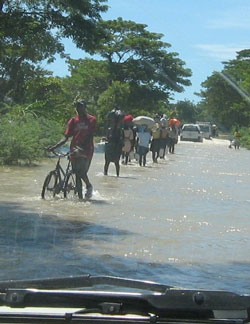 |
We’re faced with another round of death and obliteration. Haiti’s naked mountains promise many more unnatural disasters. We know that a massive reforestation program and public works to keep cities safer are what’s needed in the medium and long term. But there’s a lot we can do in the short term to help out with disaster relief.
None of us regard PIH as a disaster-relief organization. Together, we’ve built PIH—meaning the network of locally directed organizations working in 10 countries—to serve a different cause. We wanted to attack poverty and inequality and bring the fruits of modernity—health care, education, et cetera—to people marginalized by adverse social forces. It seemed likely, as reports came in this week, that many other institutions and organizations would be far better able to respond to the after-effects of storms and floods. I’d been told, as the American Airlines flight passed over flooded Gonaïves, that the city was cut off from outside help, but even as I heard this, I knew that our own colleagues were there, volunteering what meager resources we had on hand, and a few hours later I was there too. I was hoping that we’d find that the city was receiving the expert attention of organizations trained to do disaster relief. So imagine my surprise, yesterday, when I discovered that very little in the way of help had reached Gonaïves or the other flooded towns along the coast.
Although it’s not true that Gonaïves cannot be reached by vehicle, it is true that the city center is still under water, and that the road into the city is well and truly flooded. Between Pont Sonde—the only way to the coast, since the major bridge between Port-au-Prince and Gonaïves is out, as is that to the north—and the flooded city, we saw not a single first-aid station or proper temporary shelter. We saw, rather, people stranded on the tops of their houses or wading through waist-deep water; we saw thousands in an on-foot exodus south towards Saint-Marc.
We saw a couple of U.N. tanks rolling through the muddy water over these streets, some Cuban doctors, and two Red Cross vehicles (one of them stuck in mud at least 10 miles from the city), and heard and saw helicopters overhead. But for the most part the streets were full of debris, upside-down vehicles, and dazed residents looking to get out before the next rains. Our friend Deo from Burundi was there and said it reminded him of nothing so much as what he’d seen there, and in Rwanda, at the time of the genocide in 1994—long lines of people carrying little more than their children, goats, and balancing sodden bags and suitcases on their heads.
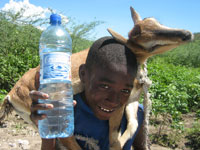 |
A speedy, determined relief effort could save the lives of tens of thousands of Haitians in Gonaïves and all along the flooded coast. The people of that city and others have been stranded without food or water or shelter for three days and it’s simply not true that they cannot be reached. When I called to say as much to friends working with the U.S. government and with disaster-relief organizations based in Port-au-Prince, it became clear that, as of yesterday, there’s not a lot of accurate information leaving Gonaïves, although estimates of hundreds of deaths are not hyperbolic. We had no cell phone coverage there and had to wait until last night to call people in Port-au-Prince. One sympathetic American friend, following up on our distress calls about a lack of relief, told me this morning the retort she’d heard from an expert employed by a U.N.-affiliated health organization: “Three days without water is nothing. People in southern Haiti affected by Gustave went ten days without water.
No human can go ten days without water. Food, perhaps. But not water. So we can expect that the people you see in these photographs, which I took by borrowing the digital camera of a ZL employee from Gonaïves (whose family, like all those you see, lost everything), are at great risk of falling ill with water-borne illnesses. There is also a lot of dead livestock floating down the streets of the city. The stench is overwhelming.
We are familiar with a lot of the Haitian officials charged with responding to this tragedy, which is, agreed, widespread. They showed up in Gonaïves: the district health commissioner, who is from the city and felt lucky to have avoided drowning; the coordinator of the government’s disaster response; nurses and doctors we’ve known over the years. They are doing the best they can with scant supplies. They are tired, thirsty themselves, hoarse-throated. Even Haiti’s newly-appointed Prime Minister, on her first day on the job, showed up this morning in Mirebalais, keeping a promise she made many months ago, long before she was directly involved in politics. She now has to install a new government, perhaps this afternoon, and respond to multiple disasters at once. These people, who are trying to help their fellow Haitians, deserve our help.
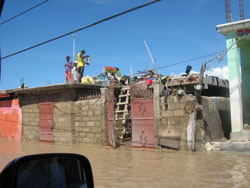 |
This is an internal appeal to staff, family, and friends. Our co-workers in Haiti are already contributing what services and supplies they can. We will withdraw from Gonaïves (as soon as we get the information we need regarding urgent supplies and as soon as we see more evidence of the mainstream disaster-relief organizations) to Saint-Marc and Petite Rivière de l’Artibonite, where we will run the hospitals and health centers with our colleagues in the Ministry of Health; we will help organized food and some clothing for people in Gonaïves and refugees being brought in today from Gonaïves.
Mirebalais is going to be under a good deal of stress. As many of you know, the city’s hospital is not really functioning (in January, local protests about the hospital led to its closing, with patients evacuated to Cange, Boucan Carre, and LaColline). To my knowledge, at least 15,000 are expected to arrive here today—and they will come with nothing. They’ll need water, food, and shelter immediately, and the Mayor of Mirebalais, with whom we met this morning, is looking for dry spaces for them (maybe schools, etc) but there’s no bedding or mosquito nets or cots, that I know of.
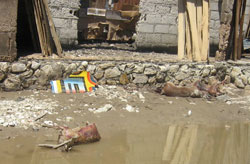 |
A U.S. Coast Guard cutter is to arrive in Gonaïve tomorrow with water and supplies, but by report last night’s attempt to dock a U.N. vessel and distribute food was not successful because of “fear of crowd control” (this was from an American friend in Port-au-Prince, so I can’t confirm anything other than what I saw: no widespread distribution of water or food or tents or tarps or anything).
Since ZL is, like all the PIH sister organizations, nimble, we can do a lot by pooling small donations from friends and family members and helping ZL respond in real time to requests from those coordinating the relief efforts. We’ll need to source things like tetanus vaccine (withdrawn from Gonaïves some months ago because of concerns over quality of a certain batch; I don’t know the details), first-aid supplies, oral-rehydration packs, and of course food, cooking oil, and fuel. Again, I know that conventional disaster-relief organizations have greater experience in logistics, and am expecting they’ll have kits prepared for precisely these needs, but as of today these supplies are conspicuous by their absence. Problems with “crowd control,” refugees, and short tempers will only increase as the days go by—especially if more rain falls, as is predicted, tomorrow and Monday.
Over 20 years ago, someone explained to me that “wet poverty is worse than dry poverty.” I wasn’t then sure what that meant, but had a pretty good idea of the misery endured by those living through the rainy season in houses that, as the Haitians say, “can fool the sun but not the rain.” I’ve repeated the maxim often enough to merit teasing from my students, but the Haitians find it neither amusing nor over-used. Trying to sleep in wet clothes, on a muddy floor, is high on the list of degradingly uncomfortable activities. It’s better to simply give up and wait until daylight.
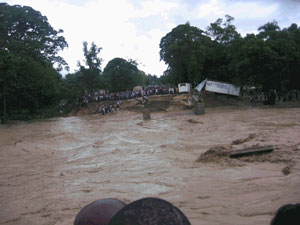 |
Surveying the devastation in Gonaïves, and the wretched population on roofs or wading through the streets or carrying bundles out of the city, we knew that these floods and the lack of effective response are not so much about the unruly forces of nature. Many of you on the Haiti team recall that we’ve long been based in a squatter settlement formed by the floodwaters of the Artibonite; that we spent years rebuilding lean-tos and shacks that didn’t even fool the sun; you’ll remember our co-worker’s mother swept away in a flash flood; or you’ve been part of a team of health workers watching helplessly as an ambulance is swept downstream before their eyes.
The world is waking up to these threats, but Haitians have long been pulling all-nighters as rainstorms keep them up rather than lull them to sleep. Please give generously to ZL’s efforts to intervene immediately, and share this with friends and family who might give even small amounts via the PIH website.
Paul Farmer
DONATE <click this link to donate online for this appeal
on form by "Honoree/Special Event" please enter: "Hurricane / HaitiAction.net"
Democracy Now: Haiti Struggles with Humanitarian Disaster in Aftermath of Deadly Storms
 |
click image for article |
---- BOOKMARK Haiti Action.net Tropical Cyclone Page for latest updates
HaitiAction.net will host a page with many Tropical Cyclone resources so you can find the latest information when you are searching for current updates. We suggest that you bookmark that page for this busy 2008 Hurricane Season.
Previous Hurricane reports:
Haiti’s deadly hurricane season just getting started Sep 1
Will Hurricane Hanna threaten Haiti? Aug 30
Dangerous Hurricane Gustav will hit Haiti Aug 25
Haiti's crops will be devastated by Hurricane Gustav Aug 26
Furious Tropical Storm Fay drenches Haiti Aug 15
View the latest NOAA observations near Hurricane IKE
More information, resources and links can be found on the HaitiAction.net Tropical Cyclone Page
For the latest advisories from the National Hurricane Center: http://www.nhc.noaa.gov/index.shtml?
Map of Haiti: rezize browser window to enlarge map
Tropical Cyclone Breakpoints - Kiskeya